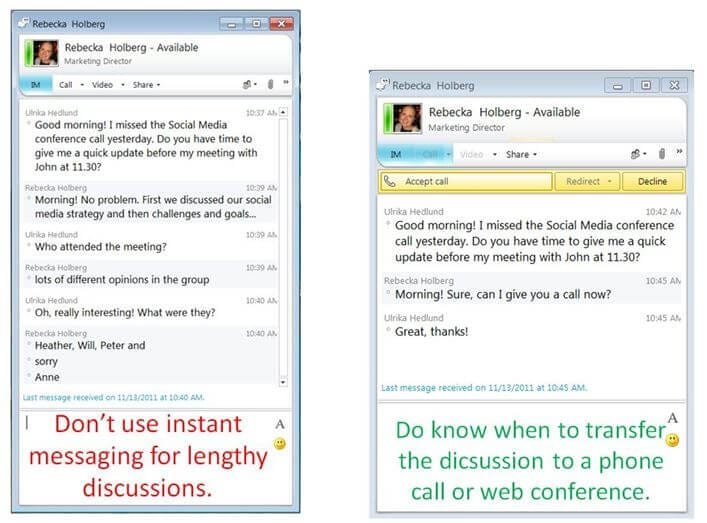Part 2 of 3: Instant Messaging Etiquette
Last week I wrote about instant messaging and how it can improve business productivity in the workplace. In this article, I want to share with you the “Do’s” and “Don’ts” of instant messaging so that you know how to use it effectively within your organization.
Best practices for instant messaging
1. Share your availability. Be sure to always set your “status” to reflect your availability. Some instant messaging clients will read information in your calendar and automatically set your status to “busy” if you have scheduled an appointment. Even if you are not in a meeting, but working on something where you don’t want to be interrupted, be sure to set your status to “busy”.
2. Be a team player. Some people I know set their status to “away” even if they are not and only initiate conversations with people when they themselves need something. This is very bad instant messaging etiquette and when people start to realize this, they won’t be as inclined to chat with you.
3. Mind your manners. Be polite and always ask the person you want to chat with if they have time. Be precise in what you want to chat about and how much time it will take. Don’t waste valuable time on obvious questions or irrelevant statements. Usually, it’s enough if one person marks the end of a conversation.
4. Not suited for emotionally heated discussions. Just like email, instant messaging is not for disputes, arguments, or other emotionally heated discussions; these should be done in a face to face meeting or over the phone. The written word often sounds much harsher than it is intended and since you can’t read the facial expression or body language of the person you are communicating with it is impossible for you to know how he or she is reacting.
5. Select the right communication method. Instant messaging is great if you need to get a response to a question you might have, to get input on something you are working on, or coordinating a quick meet up. Instant messaging is also great for initiating a conversation, but it is not necessarily the best communication method for all conversations. You might end up having parallel discussions or very confusing responses if you spend too much time writing long messages. If you are engaging in what turns out to be a lengthy discussion choose to initiate a phone call or web conference instead. In most instant messaging clients you can easily do this with just a click of a button.
6. Be professional. Using instant messaging in the workplace calls for professionalism, this includes the topics you discuss and the language you use (proper spelling and no profanities). Remember that most instant messaging platforms have built-in archiving functionality so your conversations are stored and can easily be monitored.
7. Respect working hours. If you are staying up late working and you see a colleague online it is not okay to start an instant messaging conversation with that person. He or she might be surfing the web or watching a movie and might not at all be interested in participating in a work-related discussion. If you do need to contact the person and it can’t wait till the morning, be sure to apologize for contacting the person so late and ask politely if they can help.
8. Use instant messaging with people you know. This point might vary from company to company, but in my opinion, instant messaging is not the communication method of choice if you want to initiate a conversation with someone you haven’t previously been introduced to. In that case, I would recommend that you send an email or call the person and introduce yourself first.
Lead by example
Instant messaging has been available for many years and most people have already made up their mind on whether or not they like it. Some people can’t live without it while others don’t even bother logging in. I’m pretty sure that if companies provided their employees with proper guidelines and best practices for how to use instant messaging organizations would see a lot greater value with increased business productivity. It is never too late to introduce instant messaging etiquette, so I urge you to lead by example and start using the tips I’ve given you. You can also share this article with your colleagues to make sure they improve their manners and stop wasting your time!
If you want to learn more about etiquette on the web I can recommend a great website called NetManners, here you will find more useful tips on following good manners on the Internet.
(If you have difficulties reading this article, you can access the full article here)



